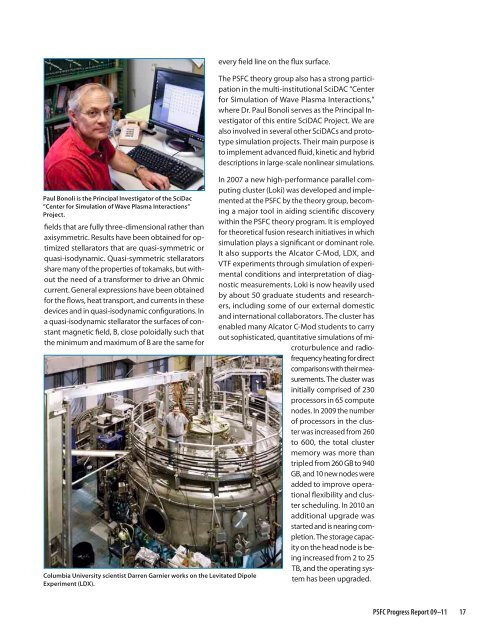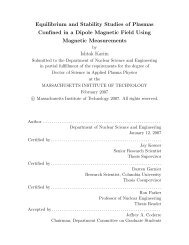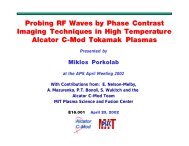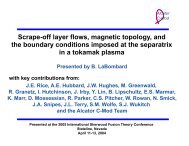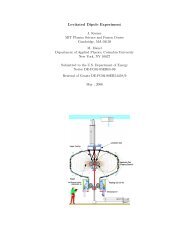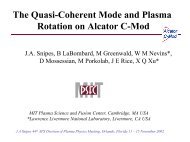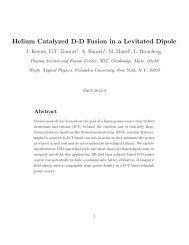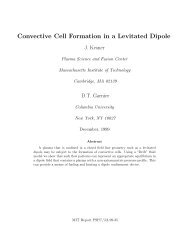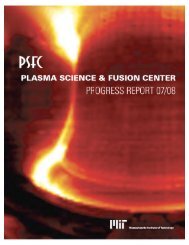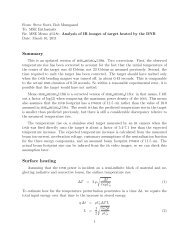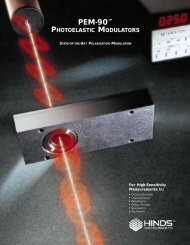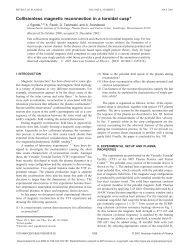Download a copy of the latest PSFC Progress Report - Plasma ...
Download a copy of the latest PSFC Progress Report - Plasma ...
Download a copy of the latest PSFC Progress Report - Plasma ...
You also want an ePaper? Increase the reach of your titles
YUMPU automatically turns print PDFs into web optimized ePapers that Google loves.
Paul Bonoli is <strong>the</strong> Principal Investigator <strong>of</strong> <strong>the</strong> SciDac<br />
”Center for Simulation <strong>of</strong> Wave <strong>Plasma</strong> Interactions”<br />
Project.<br />
fields that are fully three-dimensional ra<strong>the</strong>r than<br />
axisymmetric. Results have been obtained for optimized<br />
stellarators that are quasi-symmetric or<br />
quasi-isodynamic. Quasi-symmetric stellarators<br />
share many <strong>of</strong> <strong>the</strong> properties <strong>of</strong> tokamaks, but without<br />
<strong>the</strong> need <strong>of</strong> a transformer to drive an Ohmic<br />
current. General expressions have been obtained<br />
for <strong>the</strong> flows, heat transport, and currents in <strong>the</strong>se<br />
devices and in quasi-isodynamic configurations. In<br />
a quasi-isodynamic stellarator <strong>the</strong> surfaces <strong>of</strong> constant<br />
magnetic field, B, close poloidally such that<br />
<strong>the</strong> minimum and maximum <strong>of</strong> B are <strong>the</strong> same for<br />
Columbia University scientist Darren Garnier works on <strong>the</strong> Levitated Dipole<br />
Experiment (LDX).<br />
every field line on <strong>the</strong> flux surface.<br />
The <strong>PSFC</strong> <strong>the</strong>ory group also has a strong participation<br />
in <strong>the</strong> multi-institutional SciDAC “Center<br />
for Simulation <strong>of</strong> Wave <strong>Plasma</strong> Interactions,”<br />
where Dr. Paul Bonoli serves as <strong>the</strong> Principal Investigator<br />
<strong>of</strong> this entire SciDAC Project. We are<br />
also involved in several o<strong>the</strong>r SciDACs and prototype<br />
simulation projects. Their main purpose is<br />
to implement advanced fluid, kinetic and hybrid<br />
descriptions in large-scale nonlinear simulations.<br />
In 2007 a new high-performance parallel computing<br />
cluster (Loki) was developed and implemented<br />
at <strong>the</strong> <strong>PSFC</strong> by <strong>the</strong> <strong>the</strong>ory group, becoming<br />
a major tool in aiding scientific discovery<br />
within <strong>the</strong> <strong>PSFC</strong> <strong>the</strong>ory program. It is employed<br />
for <strong>the</strong>oretical fusion research initiatives in which<br />
simulation plays a significant or dominant role.<br />
It also supports <strong>the</strong> Alcator C-Mod, LDX, and<br />
VTF experiments through simulation <strong>of</strong> experimental<br />
conditions and interpretation <strong>of</strong> diagnostic<br />
measurements. Loki is now heavily used<br />
by about 50 graduate students and researchers,<br />
including some <strong>of</strong> our external domestic<br />
and international collaborators. The cluster has<br />
enabled many Alcator C-Mod students to carry<br />
out sophisticated, quantitative simulations <strong>of</strong> microturbulence<br />
and radi<strong>of</strong>requency<br />
heating for direct<br />
comparisons with <strong>the</strong>ir measurements.<br />
The cluster was<br />
initially comprised <strong>of</strong> 230<br />
processors in 65 compute<br />
nodes. In 2009 <strong>the</strong> number<br />
<strong>of</strong> processors in <strong>the</strong> cluster<br />
was increased from 260<br />
to 600, <strong>the</strong> total cluster<br />
memory was more than<br />
tripled from 260 GB to 940<br />
GB, and 10 new nodes were<br />
added to improve operational<br />
flexibility and cluster<br />
scheduling. In 2010 an<br />
additional upgrade was<br />
started and is nearing completion.<br />
The storage capacity<br />
on <strong>the</strong> head node is being<br />
increased from 2 to 25<br />
TB, and <strong>the</strong> operating system<br />
has been upgraded.<br />
<strong>PSFC</strong> <strong>Progress</strong> <strong>Report</strong> 09–11 17


